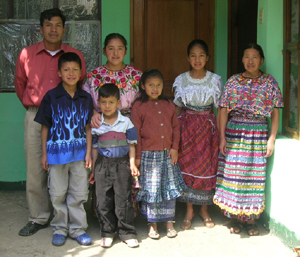K'iche'
The K'iche' (or Quiché) are one of the largest ethnic groups in Guatemala. They are ethnically Maya and live in the highlands to the north and the west of Lake Atitlán, primarily in the departments of Quetzaltenango, Totonicapan, and El Quiché.
K'iche' also denotes the traditional language of the K'iche' people. This language is still spoken in most K'iche' communities, but many community members also speak Spanish and some do not speak K'iche' at all.
History
Mythological Origins
The Popol Vuh, sometimes called the "Maya Bible," gives us an insight into the creation of the first K'iche' and relates the foundation of the K'iche' kingdom. The version of the story that is available to us today was written down in the 17th century by several members of the lineages that had ruled the kingdom until their defeat at the hands of Pedro de Alvarado and his allies.
The Popol Vuh tells us that, even before the sun rose for the first time, the first four heads of the K'iche' lineages were modeled from corn dough. They were created with the ability to see and understand everything instantly: "The moment they turned around and looked around in the sky, on the earth, everything was seen without any obstruction,"[1] but the gods worried that their creations would "become as great as gods" and limited the clarity with which their works saw. Thus were created the first fathers of the K'iche'. Next, the gods created the four women who would be the mothers of the K'iche' people. Other lineage heads, whose descendants would form the other tribes, were also created in this time before the dawn.
The lineage heads then traveled to Tulan Zuyua,[2] where they received their
Prehispanic Period
Scholarship has followed two lines in an effort to establish the origins of the K'iche' people: some scholars assert that there is evidence to suggest that the K'iche' developed as a distinct people in situ while others argue that the journey described in the Popol Vuh reflects an actual migration of lineages from further north who incorporated themselves into local groups to establish the K'iche' state. Their origins notwithstanding, it is widely agreed that the K'iche' state began with the establishment of Utatlan around the year 1200.[3] Thereafter, the power of the K'iche' expanded quickly, to encompass an extensive territory and large population.
Colonial Period
The K'iche' first made contact with the Spanish conquistadors in 1523, with the arrival of an expeditionary force led by Pedro de Alvarado.
Early Republican Period
Modern Period
Religion
Traditional Maya religious custom, or costumbre, is a syncretic conglomeration of pre-Columbian traditions and Catholicism. It combines devotion to the Catholic saints and celebrations of the Catholic festivals with traditional dances and elaborate ceremonies conducted at ceremonial sites that are scattered throughout the surrounding mountains.
Evangelical Protestantism has become increasingly strong since its arrival in the region in the 1970s.
Clothing
As in many Maya groups, clothing carries a lot of meaning for the K'iche'.
Women
References
- ↑ Tedlock 1996: 146.
- ↑ Dennis Tedlock suggests that this name might be a reference to either Kaminaljuyú or Copán
- ↑ Carmack and Weeks 1981: 323
Sources
- Carmack, Robert M. and John M. Weeks. 1981. The Archaeology and Ethnohistory of Utatlan: A Conjunctive Approach. American Antiquity 46(2): 323-341.
- Tedlock, Dennis. 1996. Popol Vuh: The Mayan Book of the Dawn of Life. New York: Simon & Schuster. ISBN 0-684-81845-0
